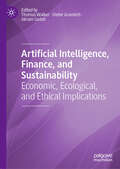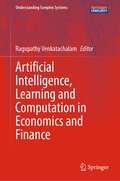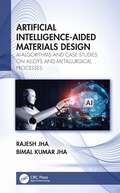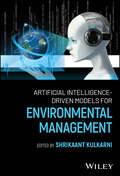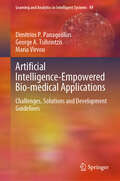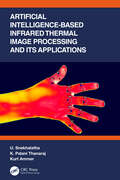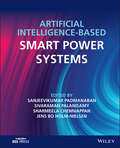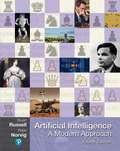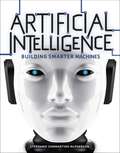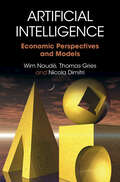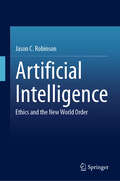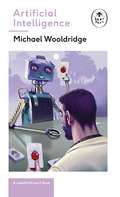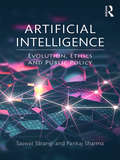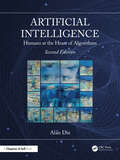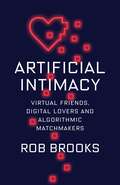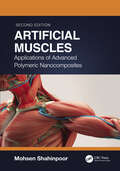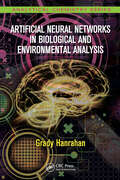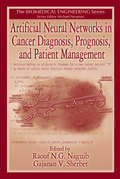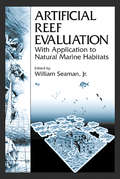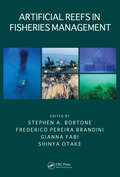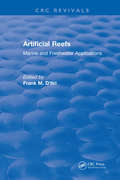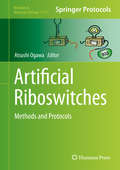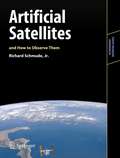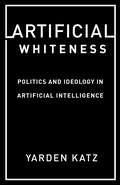- Table View
- List View
Artificial Intelligence, Finance, and Sustainability: Economic, Ecological, and Ethical Implications
by Thomas Walker Dieter Gramlich Akram SadatiAs the world increasingly recognizes the importance of sustainability, businesses and investors are looking for ways to integrate sustainable practices into their operations and investment decisions. At the same time, advancements in artificial intelligence (AI) and technology are transforming the finance industry and are enabling more data-driven decision-making. The intersection of these fields presents a significant opportunity to accelerate progress towards a more sustainable future, while also improving financial performance. This book explores the crucial role of AI in sustainability and finance, examining how financial technologies and machine learning are shaping the approach of finance professionals towards environmental, social, and governance (ESG) issues. It provides a comprehensive and integrated perspective on how these areas are becoming increasingly intertwined and examines the ethical and social implications of AI in finance and its potential to unlock new opportunities for sustainability. By focusing on the practical implications of these intersections and including both case studies and expert analysis, the book provides valuable insights for practitioners, policymakers, academics, and students alike.
Artificial Intelligence, Learning and Computation in Economics and Finance (Understanding Complex Systems)
by Ragupathy VenkatachalamThis book presents frontier research on the use of computational methods to model complex interactions in economics and finance. Artificial Intelligence, Machine Learning and simulations offer effective means of analyzing and learning from large as well as new types of data. These computational tools have permeated various subfields of economics, finance, and also across different schools of economic thought. Through 16 chapters written by pioneers in economics, finance, computer science, psychology, complexity and statistics/econometrics, the book introduces their original research and presents the findings they have yielded.Theoretical and empirical studies featured in this book draw on a variety of approaches such as agent-based modeling, numerical simulations, computable economics, as well as employing tools from artificial intelligence and machine learning algorithms. The use of computational approaches to perform counterfactual thought experiments are also introduced, which help transcend the limits posed by traditional mathematical and statistical tools.The book also includes discussions on methodology, epistemology, history and issues concerning prediction, validation, and inference, all of which have become pertinent with the increasing use of computational approaches in economic analysis.
Artificial Intelligence-Aided Materials Design: AI-Algorithms and Case Studies on Alloys and Metallurgical Processes
by Rajesh Jha Bimal Kumar JhaThis book describes the application of artificial intelligence (AI)/machine learning (ML) concepts to develop predictive models that can be used to design alloy materials, including hard and soft magnetic alloys, nickel-base superalloys, titanium-base alloys, and aluminum-base alloys. Readers new to AI/ML algorithms can use this book as a starting point and use the MATLAB® and Python implementation of AI/ML algorithms through included case studies. Experienced AI/ML researchers who want to try new algorithms can use this book and study the case studies for reference. Offers advantages and limitations of several AI concepts and their proper implementation in various data types generated through experiments and computer simulations and from industries in different file formats Helps readers to develop predictive models through AI/ML algorithms by writing their own computer code or using resources where they do not have to write code Covers downloadable resources such as MATLAB GUI/APP and Python implementation that can be used on common mobile devices Discusses the CALPHAD approach and ways to use data generated from it Features a chapter on metallurgical/materials concepts to help readers understand the case studies and thus proper implementation of AI/ML algorithms under the framework of data-driven materials science Uses case studies to examine the importance of using unsupervised machine learning algorithms in determining patterns in datasets This book is written for materials scientists and metallurgists interested in the application of AI, ML, and data science in the development of new materials.
Artificial Intelligence-Driven Models for Environmental Management
by Shrikaant KulkarniStep-by-step guidelines for the development of artificial neural network-based environmental pollution models Artificial Intelligence-Driven Models for Environmental Management delves into the application of AI across a plethora of areas in environmental management, including climate forecasting, natural resource optimization, waste management, and biodiversity conservation. This book shows how AI can help in monitoring, predicting, and mitigating environmental impacts with tremendous accuracy and speed by leveraging machine learning, deep learning, and other data-driven models. The methodologies explored in this volume reflect a synthesis of computational intelligence, data science, and ecological expertise, underscoring how AI-driven systems have been making strides in managing and preserving our planet’s natural resources. The text is structured to guide readers through numerous AI models and their practical environmental management applications, showcasing theoretical foundations as well as case studies. This book also addresses the challenges and ethical considerations related to deploying AI in ecological contexts, underscoring the importance of transparency, inclusivity, and alignment with sustainability goals. Sample topics discussed in Artificial Intelligence-Driven Models for Environmental Management include: Tools and methods for monitoring and predicting environmental pollutants faster and more accuratelyAI technology for the protection of water supplies from contamination to produce healthier foodsUse of AI for the evaluation of the impacts of environmental pollution on human healthAI and waste management technologies for sustainable agriculture and soil managementThe role of AI in environmental research and sustainability and key social and economic aspects of natural resource management through AI Artificial Intelligence-Driven Models for Environmental Management is a timely, forward-thinking resource for a diverse readership, including researchers, policymakers, environmental scientists, and AI practitioners.
Artificial Intelligence-Empowered Bio-medical Applications: Challenges, Solutions and Development Guidelines (Learning and Analytics in Intelligent Systems #49)
by Maria Virvou George A. Tsihrintzis Dimitrios P. PanagouliasThe book delves into advancements in personalized medicine, highlighting the transition from generalized treatments to tailored strategies through AI and machine learning. It first emphasizes the role of biomarkers in training predictive models and neural networks, enhancing disease diagnosis and patient management. It then explores AI-driven healthcare systems, particularly the use of microservices to improve scalability and management. Additionally, it examines regulatory challenges, the need for AI explainability, and the PINXEL framework, which defines explainability requirements using the technology acceptance model (TAM) and the diffusion of innovation theory (DOI). Furthermore, the book evaluates the capabilities of large language models, including ChatGPT and GPT-4V, in medical applications, with a focus on diagnosis and structured assessments in general pathology. Lastly, it introduces an AI-powered system for primary care diagnosis that integrates language models, machine learning, and rule-based systems. The interactive AI assistants &“Med|Primary AI assistant&” and &“Dermacen Analytica&” leverage natural language processing, image analysis, and multi-modal AI to enhance patient interactions and provide healthcare professionals with high-accuracy, personalized diagnostic support. By taking a holistic approach, the book underscores the integration of AI into healthcare, aiming to support medical professionals in patient diagnosis and management with precision and adaptability.
Artificial Intelligence-based Infrared Thermal Image Processing and its Applications
by Kurt Ammer U. Snekhalatha K. Palani ThanarajInfrared thermography is a fast and non-invasive technology that provides a map of the temperature distribution on the body’s surface. This book provides a description of designing and developing a computer-assisted diagnosis (CAD) system based on thermography for diagnosing such common ailments as rheumatoid arthritis (RA), diabetes complications, and fever. It also introduces applications of machine-learning and deep-learning methods in the development of CAD systems. Key Features: • Covers applications of various image processing techniques in thermal imaging applications for the diagnosis of different medical conditions • Describes the development of a computer diagnostics system (CAD) based on thermographic data • Discusses deep-learning models for accurate diagnosis of various diseases • Includes new aspects in rheumatoid arthritis and diabetes research using advanced analytical tools • Reviews application of feature fusion algorithms and feature reduction algorithms for accurate classification of images This book is aimed at researchers and graduate students in biomedical engineering, medicine, image processing, and CAD.
Artificial Intelligence-based Smart Power Systems
by Jens Bo Holm-Nielsen Sanjeevikumar Padmanaban Sivaraman Palanisamy Sharmeela ChenniappanARTIFICIAL INTELLIGENCE-BASED SMART POWER SYSTEMS Authoritative resource describing artificial intelligence and advanced technologies in smart power systems with simulation examples and case studies Artificial Intelligence-based Smart Power Systems presents advanced technologies used in various aspects of smart power systems, especially grid-connected and industrial evolution. It covers many new topics such as distribution phasor measurement units, blockchain technologies for smart power systems, the application of deep learning and reinforced learning, and artificial intelligence techniques. The text also explores the potential consequences of artificial intelligence and advanced technologies in smart power systems in the forthcoming years. To enhance and reinforce learning, the editors include many learning resources throughout the text, including MATLAB, practical examples, and case studies. Artificial Intelligence-based Smart Power Systems includes specific information on topics such as: Modeling and analysis of smart power systems, covering steady state analysis, dynamic analysis, voltage stability, and more Recent advancement in power electronics for smart power systems, covering power electronic converters for renewable energy sources, electric vehicles, and HVDC/FACTs Distribution Phasor Measurement Units (PMU) in smart power systems, covering the need for PMU in distribution and automation of system reconfigurations Power and energy management systems Engineering colleges and universities, along with industry research centers, can use the in-depth subject coverage and the extensive supplementary learning resources found in Artificial Intelligence-based Smart Power Systems to gain a holistic understanding of the subject and be able to harness that knowledge within a myriad of practical applications.
Artificial Intelligence: A Modern Approach
by Stuart Russell Peter NorvigArtificial Intelligence: A Modern Approach (AIMA) is a university textbook on artificial intelligence, written by Stuart J. Russell and Peter Norvig. It was first published in 1995 and the fourth edition of the book was released 28 April 2020. It is used in over 1400 universities worldwide and has been called "the most popular artificial intelligence textbook in the world". It is considered the standard text in the field of artificial intelligence. The book is intended for an undergraduate audience but can also be used for graduate-level studies with the suggestion of adding some of the primary sources listed in the extensive bibliography.
Artificial Intelligence: Building Smarter Machines
by Stephanie Sammartino McPhersonIn 2011 a computer named Watson outscored two human competitors on the TV quiz show Jeopardy! and snagged the million-dollar prize. Watson isn't the only machine keeping up with humans. The field of artificial intelligence (AI) is booming, with drones, robots, and computers handling tasks that once only humans could perform. Such advances raise challenging questions. Do Watson and other computers really think? Can machines acquire self-awareness? Is AI a promising or a dangerous technology? No machine, not even Watson, yet comes close to matching human intelligence, but many scientists believe it is only a matter of time before we reach this milestone. What will such a future look like?
Artificial Intelligence: Economic Perspectives and Models
by Wim Naudé Thomas Gries and Nicola DimitriIs Artificial Intelligence a more significant invention than electricity? Will it result in explosive economic growth and unimaginable wealth for all, or will it cause the extinction of all humans? Artificial Intelligence: Economic Perspectives and Models provides a sober analysis of these questions from an economics perspective. It argues that to better understand the impact of AI on economic outcomes, we must fundamentally change the way we think about AI in relation to models of economic growth. It describes the progress that has been made so far and offers two ways in which current modelling can be improved: firstly, to incorporate the nature of AI as providing abilities that complement and/or substitute for labor, and secondly, to consider demand-side constraints. Outlining the decision-theory basis of both AI and economics, this book shows how this, and the incorporation of AI into economic models, can provide useful tools for safe, human-centered AI.
Artificial Intelligence: Ethics and the New World Order
by Jason C. RobinsonThis thought-provoking book explores the most promising and threatening technology imaginable—artificial intelligence (AI) or thinking-machines. Following the shocking release of generative AI (ChatGPT) in 2022, questions about the future of humanity and our role as apex minds have exploded with great urgency. The book contributes uniquely to AI conversations in three main ways. First, it broaches questions often ignored by AI developers and tech-enthusiasts, including corporate responsibility and the role technology plays in the widespread manipulation of cultures for profit and power. Second, it asks big and unanswered questions about the nature of thinking, consciousness, morality, purpose, and the good life, as a means of laying the foundation needed to create a better AI. Third, by framing AI evolution in three unique stages of development—Oz, Feallan, and Adouren—it takes readers far beyond the present horizon of large language models. While being accessible to a wide audience, this book offers a thought-provoking examination of the most pressing questions and risks of AI.
Artificial Intelligence: Everything you need to know about the coming AI. A Ladybird Expert Book (The Ladybird Expert Series #27)
by Michael Wooldridge'I propose to consider the question, 'Can machines think?' Alan Turing (1950)Part of the ALL-NEW Ladybird Expert series.This book is for everyone living in the age of Artificial Intelligence. And this is an accessible and authoritative introduction to one of the most important conversations of our time . . . Written by computer scientist Michael Wooldridge, Artificial Intelligence chronicles the development of intelligent machines, from Turing's dream of machines that think, to today's digital assistants like Siri and Alexa. AI is not something that awaits us in the future. Inside you'll learn how we have come to rely on embedded AI software and what a world of ubiquitous AI might look like.What's inside?- The British mathematician Alan Turing- Can machines 'understand'?- Logical and Behavioural AI- The reality of AI today- AI tomorrow- And much more . . . For an adult readership, the Ladybird Expert series is produced in the same iconic small hardback format pioneered by the original Ladybirds. Each beautifully illustrated book features the first new illustrations produced in the original Ladybird style for nearly forty years.
Artificial Intelligence: Evolution, Ethics and Public Policy
by Pankaj Sharma Saswat SarangiWhat will the future be? A dystopian landscape controlled by machines or a brave new world full of possibilities? Perhaps the answer lies with Artificial Intelligence (AI)—a phenomenon much beyond technology that has, continues to, and will shape lives in ways we do not understand yet. This book traces the evolution of AI in contemporary history. It analyses how AI is primarily being driven by "capital" as the only "factor of production" and its consequences for the global political economy. It further explores the dystopian prospect of mass unemployment by AI and takes up the ethical aspects of AI and its possible use in undermining natural and fundamental rights. A tract for the times, this volume will be a major intervention in an area that is heavily debated but rarely understood. It will be essential reading for researchers and students of digital humanities, politics, economics, science and technology studies, physics, and computer science. It will also be key reading for policy makers, cyber experts and bureaucrats.
Artificial Intelligence: Humans at the Heart of Algorithms
by Alan DixAn authoritative and accessible one-stop resource, the first edition of An Introduction to Artificial Intelligence presented one of the first comprehensive examinations of AI. Designed to provide an understanding of the foundations of artificial intelligence, it examined the central computational techniques employed by AI, including knowledge representation, search, reasoning and learning, as well as the principal application domains of expert systems, natural language, vision, robotics, software agents and cognitive modelling. Many of the major philosophical and ethical issues of AI were also introduced. This new edition expands and revises the book throughout, with new material to augment existing chapters, including short case studies, as well as adding new chapters on explainable AI, big data and deep learning, temporal and web-scale data, statistical methods and data wrangling. It expands the book’s focus on human-centred AI, covering gender, ethnic and social bias, the need for transparency, intelligent user interfaces, and designing interactions to aid machine learning. With detailed, well-illustrated examples and exercises throughout, this book provides a substantial and robust introduction to artificial intelligence in a clear and concise coursebook form. It stands as a core text for all students and computer scientists approaching AI.You can also visit the author website for further resources: https://alandix.com/aibook/.
Artificial Intimacy: Virtual Friends, Digital Lovers, and Algorithmic Matchmakers
by Rob BrooksWhat happens when the human brain, which evolved over eons, collides with twenty-first-century technology? Machines can now push psychological buttons, stimulating and sometimes exploiting the ways people make friends, gossip with neighbors, and grow intimate with lovers. Sex robots present the humanoid face of this technological revolution—yet although it is easy to gawk at their uncanniness, more familiar technologies based in artificial intelligence and virtual reality are insinuating themselves into human interactions. Digital lovers, virtual friends, and algorithmic matchmakers help us manage our feelings in a world of cognitive overload. Will these machines, fueled by masses of user data and powered by algorithms that learn all the time, transform the quality of human life?Artificial Intimacy offers an innovative perspective on the possibilities of the present and near future. The evolutionary biologist Rob Brooks explores the latest research on intimacy and desire to consider the interaction of new technologies and fundamental human behaviors. He details how existing artificial intelligences can already learn and exploit human social needs—and are getting better at what they do. Brooks combines an understanding of core human traits from evolutionary biology with analysis of how cultural, economic, and technological contexts shape the ways people express them. Beyond the technology, he asks what the implications of artificial intimacy will be for how we understand ourselves.
Artificial Life: The Quest for a New Creation
by Steven LevyBiologists, mathematicians, and computer scientists learn what computers can do when given the opportunity to "think".
Artificial Muscles: Applications of Advanced Polymeric Nanocomposites
by Mohsen ShahinpoorSmart materials are the way of the future in a variety of fields, from biomedical engineering and chemistry to nanoscience, nanotechnology, and robotics. Featuring an interdisciplinary approach to smart materials and structures, this second edition of Artificial Muscles: Applications of Advanced Polymeric Nanocomposites has been fully updated to thoroughly review the latest knowledge of ionic polymeric conductor nanocomposites (IPCNCs), including ionic polymeric metal nanocomposites (IPMNCs) as biomimetic distributed nanosensors, nanoactuators, nanotransducers, nanorobots, artificial muscles, and electrically controllable intelligent polymeric network structures. Authored by one of the founding fathers of the field, the book introduces fabrication and manufacturing methods of several electrically and chemically active ionic polymeric sensors, actuators, and artificial muscles, as well as a new class of electrically active polymeric nanocomposites and artificial muscles. It also describes a few apparatuses for modeling and testing various artificial muscles to show the viability of chemoactive and electroactive muscles. It presents the theories, modeling, and numerical simulations of ionic polymeric artificial muscles’ electrodynamics and chemodynamics and features current industrial and medical applications of IPMNCs. By covering the fabrication techniques of and novel developments in advanced polymeric nanocomposites, this second edition continues to provides an accessible yet solid foundation to the subject while stimulating further research. Key features: Fully up to date with the latest cutting-edge discoveries in the field Authored by a world expert in the subject area Explores the exciting and growing topic of smart materials in medicine Mohsen Shahinpoor is Professor of Mechanical Engineering at the University of Maine and a leading expert in artificial muscles.
Artificial Neural Networks in Biological and Environmental Analysis (Analytical Chemistry)
by Grady HanrahanOriginating from models of biological neural systems, artificial neural networks (ANN) are the cornerstones of artificial intelligence research. Catalyzed by the upsurge in computational power and availability, and made widely accessible with the co-evolution of software, algorithms, and methodologies, artificial neural networks have had a profound
Artificial Neural Networks in Cancer Diagnosis, Prognosis, and Patient Management
by R. N. G. Naguib G. V. SherbetThe potential value of artificial neural networks (ANN) as a predictor of malignancy has begun to receive increased recognition. Research and case studies can be found scattered throughout a multitude of journals. Artificial Neural Networks in Cancer Diagnosis, Prognosis, and Patient Management brings together the work of top researchers - primaril
Artificial Reef Evaluation: With Application to Natural Marine Habitats
by William SeamanBeneath the coastal waters of the world lie thousands of artificial reefs. Some are old and retired freighters and ships that once plied the oceans of the world but now serve as habitats for marine life. Others are newer reefs that have been designed and built for specific applications. With the field of aquatic habitat technology continually growi
Artificial Reefs in Fisheries Management (CRC Marine Biology Series)
by Stephen A. Bortone Shinya Otake Frederico Pereira Brandini Gianna FabiWhile artificial reefs may have much to offer, they remain an anecdote in the greater scheme of fisheries management, primarily due to the lack of data specific to validating their use. Based on papers presented at the 9th Conference on Artificial Reefs and Artificial Habitats (CARAH) and also including original articles written for this reference,
Artificial Reefs: Marine and Freshwater Applications
by Frank M. D'itriIn this book fisheries biologists, ecologists, limnologists, oceanographers, aquatic resource managers and planners, commercial fisherman and environmental scientists are offered information on the latest artificial fishing reef designs, siting and placement methods, and ecological research as well as an overview of current united states legislation and regulations.
Artificial Riboswitches: Methods and Protocols (Methods in Molecular Biology #1111)
by Atsushi OgawaArtificial riboswitches and other ligand-responsive gene regulators make it possible to switch protein synthesis ON or OFF with arbitrary ligand molecules. Artificial Riboswitches: Methods and Protocols focuses on the state-of-the-art methods developed in recent years for creating artificial riboswitches, therefore this volume could be regarded as a collection of recipes for the gene circuit elements in synthetic biology and metabolic engineering. Chapters cover topics such as screening or rational design methods for obtaining artificial riboswitches that function in either bacterial or eukaryotic translational systems, protocols for evaluating the activities of the resultant riboswitches, as well as protocols for construction of ligand-dependent, trans-acting gene regulators. Written in the successful Methods in Molecular Biology series format, chapters include introductions to their respective topics, lists of the necessary materials and reagents, step-by-step, readily reproducible protocols, and notes on troubleshooting and avoiding known pitfalls. Authoritative and easily accessible, Artificial Riboswitches: Methods and Protocols seeks to serve not only bioengineers who aim to reprogram cell behaviors and molecular biologists who leverage these regulators for genetic studies, but to all researchers interested in this fascinating field.
Artificial Satellites and How to Observe Them (Astronomers' Observing Guides)
by Richard Schmude Jr.Every amateur astronomer - and many non-astronomers - will be familiar with seeing a "star" that shows that characteristic steady slide across the starry background of the sky. Artificial satellites can be seen any night, and some as bright as the planets. But how many of us can identify which satellites or spent launch vehicle casing we are seeing? Artificial Satellites and How to Observe Them describes all the different satellites that can be observed without optical aid, including of course the International Space Station and the many spy satellites operated by different nations. Richard Schmude looks at them in detail and describes how they can be observed by amateurs, how to recognize them, and even how to predict their orbits. Artificial satellites have changed since the beginning of the millenium. Several additional countries have launched them. And amateur astronomers have utilized digital cameras in order to image satellites to a resolution of about three feet. This book describes how to recognize, observe, and image satellites. Examples of recent images and how they were made are given. It also offers up-to-date descriptions of the many satellites that are orbiting the Earth and other celestial bodies. Readers can learn how satellites impact our day-to-day lives. In short, Artificial Satellites and How to Observe Them is a detailed and up-to-date overview of artificial satellites and how to study them in the night sky.
Artificial Whiteness: Politics and Ideology in Artificial Intelligence
by Yarden KatzDramatic statements about the promise and peril of artificial intelligence for humanity abound, as an industry of experts claims that AI is poised to reshape nearly every sphere of life. Who profits from the idea that the age of AI has arrived? Why do ideas of AI’s transformative potential keep reappearing in social and political discourse, and how are they linked to broader political agendas?Yarden Katz reveals the ideology embedded in the concept of artificial intelligence, contending that it both serves and mimics the logic of white supremacy. He demonstrates that understandings of AI, as a field and a technology, have shifted dramatically over time based on the needs of its funders and the professional class that formed around it. From its origins in the Cold War military-industrial complex through its present-day Silicon Valley proselytizers and eager policy analysts, AI has never been simply a technical project enabled by larger data and better computing. Drawing on intimate familiarity with the field and its practices, Katz instead asks us to see how AI reinforces models of knowledge that assume white male superiority and an imperialist worldview. Only by seeing the connection between artificial intelligence and whiteness can we prioritize alternatives to the conception of AI as an all-encompassing technological force.Bringing together theories of whiteness and race in the humanities and social sciences with a deep understanding of the history and practice of science and computing, Artificial Whiteness is an incisive, urgent critique of the uses of AI as a political tool to uphold social hierarchies.
